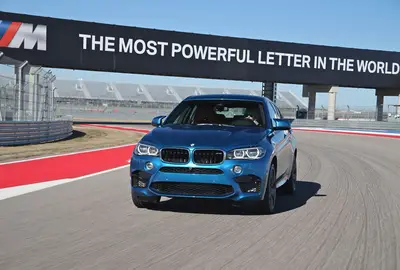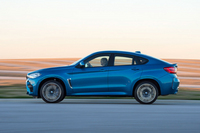2015 BMW X6 M Review, Pt 2 by Henny Hemmes +VIDEO
 2015 BMW X6 M |
HIGH PERFORMANCE HEAVY WEIGHT
By Henny Hemmes
Senior European Editor
• SEE ALSO: BMW Buyers Guide
February 4, 2015 - Late last week, I reported on my first encounter with the new BMW X6 M at the Circuit of the Americas in Austin, TX. I admit that the latest M model left me and my colleagues nearly speechless. We could not have guessed that a 193 inches long SUV, weighing over 5,000 pounds (2300 kg) would be so light-footed on a race track.
Perhaps not all X6 M customers will have the opportunity to take their car out for a couple of laps at race speed, but there will be quite some who are a member of the SCCA (Sports Car Club of America), for example, who will be able to find a local track event to participate in with their new M model. I'm certain they will leave some bewildered drivers behind.
 2015 BMW X6 M |
The development engineers of BMW M did a great job, no doubt due to the significant experience they obtained by building the 2009 model, which was the first all-wheel-drive X cars to get the M-badge. For the new X5/X6 pair, the goal was to take the new M Sports Activity Coupe to an even higher level.
Here's how they did it: The M engineers developed the most powerful engine ever for a BMW all-wheel drive vehicle. The new 4.4-liter V8 produces 423 kW/575 hp, which is four percent more than its predecessor. Peak torque increased by 70 Nm (52 lb-ft), a rise of 10 per cent. Tot 750 Nm/553 pound-feet between 2,200 and 5,000 rpm. In combination with the standard 8-speed M steptronic transmission, the power plant propels the X6 M in 4.2 seconds from a standstill to 62 mph.
BMW would not be BMW if they didn't also consider the need to address fuel economy: fuel consumption for the big car has been cut by 20 percent to 11.1 liter/km or 25.5 mpg (imperial gallon). However, I do not think that the typical lucky of these cars will worry very much about fuel consumption…
It is so nice to test a fast car on the race track. We were really able to experience applying launch control to accelerate onto three-figure speed, helped by the xDrive all-wheel traction. The top speed has been electronically limited to 250 km/h/ 155 mph but when you buy the M Driver’s Package the top speed increases to 280 km/h/174 mph.
My only criticism it that I miss the more pronounced V8 rumble!
When developing a fast version of a vehicle, elimination of roll is extremely important. This is particularly true for a heavy SUV that also has a high center of gravity - in this case, 24.4 inches/62 cm. Therefore, the M engineers took a lot of measures, such as revising the front suspension, applying stiffer springs, lowering it by 10 millimeters and eliminating most of the electronic stabilization. Indeed, the big car stays flat in the bends and hardly shows any tendency to under steer its fat Michelin rubber around the optional 21-inch wheels. It feels like it's glued to the asphalt.
Markus Gratzl, in charge of chassis engineering, said that the front suspension had been changed by shortening the upper arms of the wishbones by 30 mm (just over an inch) to increase camber. For insiders: between -20’ and -40’, while standard is -20’.
Project Engineer Walter Haupt said, “We wanted to make this all-wheel-drive car behave like one with rear-wheel drive. This required a full integration of all systems as well as to make them all work together. For instance, our Dynamic Performance Control (BMW’s name for torque vectoring, which distributes torque between the rear wheels) has to work with the all-wheel-drive system. To eliminate most of the electronic stabilization Dynamic Stability Control (DSC) has been optimized for driving dynamics and safety (brake standby, brake drying and fading compensation, while start-of assistant and parking brake with automatic hold have been added for comfort."
The driver has a choice of three modes: On, off, and MDM (M Dynamic Mode, which allows more wheel slip but will intervene if a preset dynamic limit is exceeded). With DSC off, the system allows the driver to take the car to the limit on the track and only intervenes in extreme situations that involve huge shifts in lateral acceleration.
The test cars were equipped with optional 21-inch wheels with specially developed ultra-high-performance Michelin Pilot Super Sport, 285/35-21 up front and 325/30-21 in the rear. During the development, Michelin patented a number of new technologies including Bi-Compound tread, which was originally designed for endurance racing. It uses different compounds on the left and right sides of the tread to offer maximum grip in difficult driving conditions.
Another innovation is the Variable Contact Patch 2.0, which changes shape depending on the driving conditions. For instance if the patch’s shape changes during cornering, the amount of rubber that is in contact with the road remains the same.
During our handful of test laps, traction remains pretty constant. Only when I rode shotgun with Bill Auberlen in the Pace Car, could you feel that the X6 M’s front wheels started to lose a bit of grip. In the display it showed that the tire pressure went up from 39 to 42 psi. But Bill had been driving far more fast laps than the five we were allowed to do, which means that after each stint the tires and brakes were cooled. All discs are perforated and inner-vented, the brake linings are of a racing compound and they are 50 per cent larger than those on the predecessor. Upfront are large six- piston calipers at the front, including pads with racing compound. .
To improve steering in the middle range, the bushes for the front axle and lower links have been redesigned. For instance, the lower wishbone bushing up front is now 10 times stiffer than standard. The M Servotronic steering – comfort, Sport, Sport+ - can be set up bv the button in the center console. This also goes for the shock dampers (Dynamic Damper Control).
We were instructed to apply the M1 button in the steering wheel, which is nice for a couple of laps to learn the track without having to think about the car. But then you would go to M2 and use different settings. With hindsight, it was a pity that while we were still sitting in the pit lane, I had not taken the time to adjust the car fully to my likings. The system was preprogrammed for the M DM setting, but I would rather have had a more firm steering feel instead of the lightest of the three possibilities. Well, it is a lesson learned and not to be forgotten when there is another chance to drive an M car on the track. It did not change the fact that the X6 M remained fully under control.
The excellent sport seat provides ample support and the ideal position behind the steering wheel is easily found and offers good view on the track and around the car.
The BMW X6 is a big car in a niche that BMW has created and where more manufacturers are now offering their performance models, such as the Mercedes AMG GLE63 S Coupe with 577 hp. With the M variant, the X6 line has gotten an impressive performance model, but you will have to be a potential customer for a seriously sized premium Sports Activity Vehicle in the first place.
The 2015 BMW X6M will reach markets world wide on April 11.
Technical details BMW X6 M
Engine: 4.4-liter V8, M TwinPower turbo technology, TwinScroll biturbo, PH direct injection, Valvetronic.
Max. output: 423 kW/575 hp @ 6,000-6,500 rpm.
Max. torque: 750 Nm/ lb-ft @ 2,200-5,000 rpm
Transmission: 8-speed Steptronic
Steering: electrical power steering with M-specific servotronic
Length/width/height: 4,909/1,989/1,689 mm / 193.3/78.3/66.5 inches
Wheel base: 2,933 mm / 115.4 in.
Track fr/rr: 1,666/1,667 mm / 65.69/65.72 in.
Ground clearance: 195 mm /7.67 in.
Tires: front/rear: 285/40R20 / 325/35 R 20
Acceleration: 0-62 in 4.2 sec.
Top speed: 250 km/h(155 mph). w/M Driver’s package 280 km/h (177 mph)
Fuel consumption: comb. 11,1/100 km EU cycle (25.5 mph imp),
CO2 emission: 258 g/km.
Base price: USA $ 103,050, Germany € 117.700


